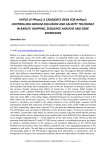Статьи журнала - Журнал стресс-физиологии и биохимии
Все статьи: 984
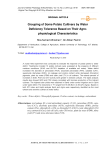
Статья научная
A 2-year field experiment was conducted to evaluate the response of potato plants to water deficit. Treatments included 10 potato cultivars were evaluated at the presence of different moisture conditions (30-40 and 60-70% depletion of available soil water). Water deficit increased the activities of peroxidase (POX), ascorbate peroxidase (APX), catalase (CAT), superoxide dismutase (SOD), ion leakage and proline content while decreased chlorophyll pigments, plant dry mass (PDM) and tuber yield (TY) in all cultivars. The extents percent of increases in SOD, POX and CAT activity were greater in tolerant cultivars. The biplot analysis results also showed SOD and POX closely correlated with biomass production of the tolerant cultivars. The highest tuber yields were obtained in Santé under control irrigation and in Spirit under water deficit. The reductions in TY ranged from 55.08 (Born) to 83.42% (Agria). Based on both STI index and biplot analysis Spirit and Agria were respectively identified as the most tolerant and sensitive cultivars to water deficit.
Бесплатно
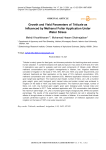
Статья научная
Triticale is mainly grown for feed grain, and biomass production for thatching straw and common human utilization. A combined analysis with split plot layout in two years of 2016 and 2017 with 5 replications was used to evaluate yield and yield components of triticale under different methanol concentrations and irrigation managements in Isfahan, Iran. Irrigation treatments consisted of irrigation on the basis of 70%, 80%, 90% and 100% crop water requirements, and methanol treatments as foliar application on the basis of 15% methanol concentration, 30% methanol concentration and control treatment (0%). Methanol application influence a hundred grain weight was significant. The maximum plant height, number of tillers, LAI, LAD, a hundred grain weight, grain yield, biological yield, harvest index and protein content was achieved in irrigation on the basis of 100% crop water requirement. The maximum plant height, number of tillers, LAI, LAD, one hundred grain weight, grain yield, biological yield, harvest index and protein was obtained in 2017. Foliar methanol application with 15% concentration had obtained the maximum plant height, LAI, LAD, a hundred grain weight, biological yield, SPAD and protein percentage. The results of this experiment suggest that methanol can aid in alleviating the effects of drought stress on triticale in climatic condition of Isfahan. It is concluded that triticale cultivars performed superior in 2017, with 15% concentration of methanol application and irrigation on the basis of 100% crop water requirement.
Бесплатно
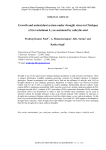
Статья научная
Drought is one of the major factors limiting chickpea production in arid and semi arid regions. There is meagre information available regarding genotypic variation for drought tolerance in chickpea genotypes. Present investigation was carried out to find out the influence of salicylic acid (SA) on drought tolerance in four chickpea genotypes. Reduction in relative injury was observed in plants treated with SA @1.5 mM as compared to control seedlings. Relationship between relative water content (RWC), membrane permeability (MP), ascorbic acid (AsA), proline, lipid peroxidation (LPO), hydrogen peroxide (H2O2), catalase (CAT), peroxidase (POX), superoxide dismutase (SOD), ascorbate peroxidase (APX) was determined in order to find out whether these parameters can be used as selection criteria for drought tolerance in this crop. Results indicate wide variation in tolerance to drought stress amongst chickpea cultivars at both the critical stages i.e. pre- and post-anthesis. On the basis of growth and antioxidant activity better genotypes Tyson and ICC-4958 appear to be adapted to drought stress tolerance. Early drought stress (pre-anthesis drought) was found to be more damaging than the late drought stress (post- anthesis drought).
Бесплатно
Статья научная
A pot experiment was conducted to study the effects of silicon (Si) and/or potassium (K) on plant growth, nitrogen uptake and N 2-fixation in water stressed (FC1) and well watered (FC2) chickpea plants using 15N and 13C isotopes. Three fertilizer rates of Si (Si 50, Si 100 and Si 200) and one fertilizer rate of K were used. For most of the growth parameters, it was found that Si either alone or in combination with K was more effective to alleviate water stress than K alone. Increasing soil water level from FC1 to FC2 often had a positive impact on values of almost all studied parameters. The Si 100K + (FC1) and Si 50K + (FC2) treatments gave high enough amounts of N 2-fixation, higher dry matter production and greater nitrogen yield. The percent increments of total N 2-fixed in the above mentioned treatments were 51 and 47% over their controls, respectively. On the other hand, increasing leave’s dry matter in response to the solely added Si (Si 50K - and Si 100K -) is associated with lower Δ 13C under both watering regimes. This may indicate that Si fertilization had a beneficial effect on water use efficiency (WUE). Hence, Δ 13C could be an adequate indicator of WUE in response to the exogenous supply of silicon to chickpea plants. Our results highlight that Si is not only involved in amelioration of growth and in maintaining of water status but it can be also considered an important element for the symbiotic performance of chickpea plants. It can be concluded that the synergistic effect of silicon and potassium fertilization with adequate irrigation improves growth and nitrogen fixation in chickpea plants.
Бесплатно
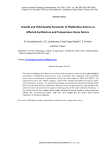
Статья научная
This work investigates the influence of moisture and temperature stress on plant phenological parameters of Phyllanthus amarus plant. A pot experiment was conducted under controlled water stress environment in greenhouse during the Rabi season of 2007 and 2008 at the Experimental Farm area, JNKVV, Jabalpur. Plants were treated with different levels of water and temperature stresses. The experimental design was Completely Randomized Design (CRD) with six treatments and five replications. Moisture stress has been given on selected dates for which the sets of pot were first brought to field capacity and the water withhold till wilting. It was found that the Plant height, Root length, Number of leaves, Number of branches per plants, No. of fruits per plant, Leaf area, Dry weight gm per plant were found maximum in control condition.
Бесплатно
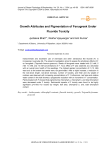
Growth attributes and pigmentation of fenugreek under fluoride toxicity
Статья научная
Indiscriminate and exorbitant use of chemicals and other xenobiotics like fluoride (F) is increasing in everyday life. The present investigation aimed to assess the phytotoxic effects of F on fenugreek ( Trigonella foenum-graecum ). Seeds of fenugreek were treated with 2.5 mM, 5 mM, 7.5 mM, and 10 mM concentrations of F. Toxic effect of F was observed as a decrease with an overall poor health of the seedlings. The highest applied concentration of F (10 mM) was toxic to the extent that seeds were not germinated. After a slight increase, a reduction in the root-shoot length, root-shoot biomass, number of nodules, and fresh and dry weight of nodules was observed with increasing concentrations of F. Furthermore, leaf area and relative water content in the leaf showed a progressive reduction with an increment in F concentration. Plants treated with F showed that pigments like chlorophyll a, chlorophyll b, and total chlorophyll were decreased under F toxicity. Detrimental impacts of F toxicity were found to be highly significant (p=0.001) for nodule dry weight, leaf area, chlorophyll a, and, total chlorophyll content.
Бесплатно
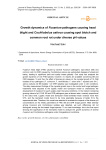
Статья научная
Fusarium head blight (FHB) caused by several Fusarium pathogens, spot blotch (SB) and common root rot (CRR) caused by Cochliobolus sativus are well-studied diseases of wheat and barley, leading to significant yield and quality losses globally. One study has analyzed the growth dynamics of one FHB species; however, no reports are available concerning SB and CRR diseases. To end this, the effect of diverse pH values on the mycelial growth of 16 FHB isolates of four pathogens ( F. culmorum , F. verticillioides , F. solani and F. equiseti ) and 54 C. sativus cultures (32 SB isolates + 22 CRR isolates) was investigated under in vitro conditions. The daily measurement findings of the mycelial growth zone in the control and fungal pathogen treatments were adjusted to the logistic model and Gompzert model to characterize the development of mycelium for each isolate under the same conditions. In the medium containing growing values of pH, FHB, SB and CRR pathogens grew at slower rates, inversely proportional to the value level. Logistic model and Gompzert model exhibited mean variance more than 97%, and the Gompzert model found to be more applicable because of better fit to the experimental data. Therefore, this model was selected to evaluate the impacts of the diverse pH concentrations on the kinetic parameters of FHB, SB and CRR fungal growth. Wide diversity among Fusarium and Cochliobolus isolates was detected, yet such differences did not distinguish among the five tested fungal species. To our best knowledge, this is the first report showing the significance of the Gompertz model to analyze the growth dynamics of several Fusarium and Cochliobolus pathogens under changeable pH conditions.
Бесплатно
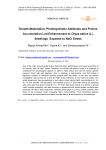
Статья научная
One of the main environmental factors that limits plant performance and lowers production is soil salinity, such as NaCl stress. Therefore, to cultivate salt-tolerant crops, it is essential to understand the physiological aspects of plant to NaCl stress and use the natural genetic resource linked with salt tolerance. Rice is relatively a salt-sensitive crop that shows a significant variation in metabolic activities towards NaCl salt stress. In this view, the present investigation was carried out to find the NaCl stress tolerance of rice (ASD-16) variety. The whole experiment was accomplished in pot culture under varying NaCl concentrations (0, 25, 50, 75, and 100mM). The salt stress was imposed on the 13th days after sowing and sampling were done after five days of treatment i.e, 18th DAS. Salt stress results in a decline in growth traits, biomass production, and also reduction in carotenoids and soluble protein contents were observed with hike in NaCl treatments. However, Chlorophyll a, b, (a+b), proline contents, were found to be increased under increasing NaCl concentrations. Thus, enhancing pigment constituents and osmolytes accumulation provides salinity stress tolerance to rice seedlings.
Бесплатно
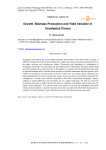
Growth, Biomass Production and Yield Variation in Eucalyptus Clones
Статья научная
Eucalyptus are among the most widely cultivated forest trees in the world under a range of different climates for products that include pulp, paper fuel wood and solid wood products such as poles, furniture and construction timber. Productivity and profitability of plantations of Eucalyptus have been revolutionized with the development of genetically improved, fast growing and high yielding Clonal planting stock of Eucalyptus. Eucalyptus Clonal planting has been said to have advantages which includes quick provision of benefits associates with fast growth, short rotation for production of pulp wood (of around 70 MT ha-1 in 6 years) ready marketing and easy establishment and less maintenance needs. Clonal planting one among the approach for management of water and nutrients compared to the other conventional strategies. Studies relating to Clonal difference and evaluation for dry matter production will help to overcome productivity loss due to deficit rainfall and optimum utilization of available natural resources for higher wood production. The present study was carried out to test the hypothesis that there exists a Clonal variation in growth, biomass production and yield and the present study gives an insight in to Clonal variation in with reference to growth, biomass production and yield.
Бесплатно
Статья научная
The present pot experiment was an attempt to monitor the beneficial effects of silicon (Si) and/or potassium (K) applications on growth and nitrogen uptake in barley plants grown under water (FC1) and non water (FC2) stress conditions using 15N and 13C isotopes. Three fertilizer rates of Si (Si 50, Si 100 and Si 200) and one fertilizer rate of K were used. Dry matter (DM) and N yield (NY) in different plant parts of barley plants was affected by Si and/ or K fertilization as well as by the watering regime level under which the plants have been grown. Solely added K or in combination with adequate rate of Si (Si 100) were more effective in alleviating water stress and producing higher yield in barley plants than solely added Si. However, the latter nutrient was found to be more effective than the former in producing higher spike's N yield. Solely added Si or in combination with K significantly reduced leave's ∆ 13C reflecting their bifacial effects on water use efficiency (WUE), particularly in plants grown under well watering regime. This result indicated that Si might be involved in saving water loss through reducing transpiration rate and facilitating water uptake; consequently, increasing WUE. Although the rising of soil humidity generally increased fertilizer nitrogen uptake (Ndff) and its use efficiency (%NUE) in barley plants, applications of K or Si fertilizers to water stressed plants resulted in significant increments of these parameters as compared with the control. Our results highlight that Si or K is not only involved in amelioration of growth of barley plants, but can also improve nitrogen uptake and fertilizer nitrogen use efficiency particularly under water deficit conditions.
Бесплатно

Статья научная
A field experiment was conducted to study the impact of different nitrogen fertilizer rates (0, 50, 100 and 150 kg N/ha as urea) on dry matter yield, nitrogen uptake (N), seed yield, seed oil content and properties of sunflower using the 15N labeling technique. Sunflower plants responded to increasing N supply with respect to growth performance. Dry matter yield (DM) and total N uptake were significantly increased with increasing N-supply. Regardless of N-fertilizer rates, partitioning of N yield in different plant parts showed that capitulum was the principle sink of N (60%) followed by leaves (30%) and stem (10%). Seed yield was significantly increased at higher N-supply. However, seed oil content was reduced in the N-fertilized treatments. Decreasing of seed oil content due to N addition was overcompensated by the seed yield increase. Consequently, oil yield was almost the same amongst all treatments. No clear trend of the effect of N supply on oil quality parameters was observed. Nitrogen derived from fertilizer (Ndff) was significantly increased with increasing N-supply. Regardless of N fertilizer rate, mean value of the %15NUE was 64%. This efficiency was less pronounced in stem and leaves than that in capitulum which had a greater value (69%) at higher N-supply.
Бесплатно
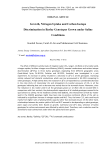
Статья научная
The effect of different salinity levels of irrigation water (ECw range 1-12 dS/m) on dry matter yield, nitrogen uptake, fertilizer nitrogen use efficiency (%NUE), stomatal conductance and carbon isotope discrimination (Δ13C‰) in three barley genotypes originating from different geographic areas (Arabi.Abiad, Syria; Pk-30-136, Pakistan and WI-2291, Australia) was investigated in a pot experiment. An increase in salinity resulted in a decrease in Δ13C in all the genotypes. Increasing salinity reduced leaf stomatal conductance which was less pronounced in WI-2291 comparing to other genotypes. At high salinity level, the reduction in Δ13C corresponded to a considerable decrease in the ratio (Ci/Ca) of intercellular (Ci) and atmospheric (Ca) partial pressures of CO2 in all the genotypes indicating that such a decrease was mainly due to the stomatal closure. Moreover, since the reduction in dry matter yield in all the genotypes grown at 12 dS/m did not exceed 50% in comparison with their controls, the photosynthetic apparatus of all studied genotypes seemed to be quit tolerant to salinity. At the moderate salinity level (8dS/m), the enhancement of leaf dry matter yield in the WI2291 genotype might have been due to positive nutritional effects of the salt as indicated by a significant increase in nitrogen uptake and NUE. Thus, the lower Ci/Ca ratio could result mainly from higher rates of photosynthetic capacity rather than stomatal closure. On the other hand, relationships between dry matter yield or NUE and Δ13C seemed to be depending on plant genotype, plant organ and salinity level. Based on growth, nutritional and Δ13C data, selection of barley genotypes for saline environments was affected by salinity level. Therefore, such a selection must be achieved for each salinity level under which the plants have been grown.
Бесплатно
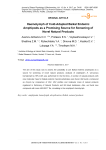
Статья научная
The aim of this study was to assess the possibility to use Baikal endemic amphipods as a source for screening of novel natural products. Analysis of amphipod’s E. verrucosus hemolymph by HPLC-MS was performed for the first time. A number of natural products with new molecular mass for Baikal endemic macroinvertebrates were found. We found a compound as chrysin by comparison of MS1, MS2 profiles and molecular mass of natural products registered in Dictionary of Natural Products and MZ-cloud databases. Also, we found new compound with mass 493.80277 Da, circulating in the amphipod’s hemolymph.
Бесплатно
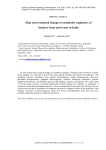
Heat stress induced changes in metabolic regulators of donkeys from arid tracts in India
Статья научная
To find out heat stress induced changes in metabolic regulators of donkeys from arid tracts in India, blood samples were collected to harvest the serum during moderate and extreme hot ambiences. The metabolic enzymes determined were sorbitol dehydrogenase, malate dehydrogenase, glucose-6-phosphate dehydrogenase, glutamate dehydrogenase, ornithine carbamoyl transferase, gamma-glutamayl transferase, 5'nucleotidase, glucose-6-phosphatase, arginase, and aldolase. The mean values of all the serum enzymes increased significantly (p≤0.05) during hot ambience as compared to respective values during moderate ambience. It was concluded that increased activity of all the enzymes in the serum was due to modulation of metabolic reactions to combat the effect of hot ambience on the animals. Activation of gluconeogenesis along with hexose monophosphate shunt and urea cycle probably helped the animals to combat the heat stress.
Бесплатно
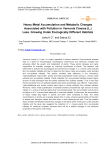
Статья научная
Vernonia cinerea (L.) Less. is a major ingredient of natural medicine. Environmental stresses lead to a series of morphological, physiological, biochemical and molecular changes that adversely affect the growth and metabolism of plants. These abiotic stresses are highly responsible for dramatic changes on chemical constituents of plants. The research was performed to analyze the physiological and biochemical changes in V. cinerea under polluted and non-polluted habitats and also to determine the heavy metal accumulation under polluted and non-polluted habitats. The studies revealed clear difference in the chlorophyll, malondialdehyde, total protein, proline and total carbohydrate content among V. cinerea under polluted and non-polluted habitats. Plants collected from non-polluted habitats showed higher amount of total chlorophyll than the plants collected from polluted habitats. Thus it was clear that the samples from non-polluted habitats were photo synthetically very efficient. Total protein, malondialdehyde and proline content were higher in plants collected from polluted habitats. Moreover, heavy metal quantification of samples showed comparatively high amount of heavy metals in V. cinerea of polluted plants than non-polluted plants. Zinc accumulation was found to be higher in all V. cinerea plants especially in road side habitats. Furthermore, the accumulation of heavy metals was higher in leaves and stem when compared to roots. The metal concentrations in shoots are invariably greater than in roots, showing special ability of the plant to absorb and transport metals and store them in their above-ground part. Thus the present study revealed remarkable biochemical changes in the plants which were grown under polluted habitats and the study also suggests the collection of V. cinerea plants from non-polluted habitats for medicinal purposes, because there will be a definite changes in the medicinal properties of the plants under stress.
Бесплатно
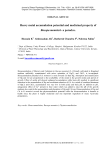
Heavy metal accumulation potential and medicinal property of Bacopa monnieri- a paradox
Статья научная
Bioaccumulation of Mercury and Cadmium in Bacopa monnieri (L.) Pennell, cultivated in Hoagland medium artificially contaminated with micro quantities of HgCl2 and CdCl2 is investigated. Bioaccumulation potential of B. monnieri is more towards Cd than Hg. Absorption and translocation of Hg and Cd are proportional to the availability of the metal in the growth media and period of growth. Effect of acidic pH showed enhanced accumulation while basic pH resulted in significant reduction in the accumulation of Hg and exorbitant reduction of Cd. As a result of combined treatment of HgCl2 and CdCl2, accumulation was very low in both acidic and basic pH. In addition to pH, antagonistic effect of Ca2+ present in lime water which was added to raise the pH of the growth medium also controls the accumulation and absorption of Hg and Cd ions. Bioaccumulation of Hg and Cd in B. monnieri reveals the phytoremediation potential while the bioaccumulation is hazards to health since the plant is highly medicinal and one important ingredient of many Ayurvedic preparations.
Бесплатно
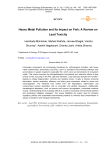
Heavy metal pollution and its impact on fish: a review on lead toxicity
Статья обзорная
Freshwater ecosystems are increasingly threatened by anthropogenic activities, with heavy metal contamination, particularly Lead (Pb). Lead is a persistent environmental pollutant, that accumulates in aquatic organisms especially fish, which serve as bioindicators of ecosystem health. This review examines the histopathological, biochemical and molecular effects of lead toxicity on fish, focusing on the liver, gills and intestines. Lead exposure disrupts liver function, leading to cellular degeneration, necrosis and oxidative stress. In gills, it induces structural deformities, impairs respiratory efficiency and alters gene expression related to stress and osmoregulation. The intestinal tract suffers from villi degradation, inflammation and compromised nutrient absorption due to enzymatic and genetic disruptions. Additionally, hematological alterations, such as anemia and immune dysregulation, exacerbate systemic toxicity. Understanding these toxicology effects is crucial for assessing environmental pollution and developing mitigation strategies. This review highlights the urgent need for stringent regulatory policies and sustainable environmental practices to minimize lead contamination in aquatic ecosystems and safeguard biodiversity.
Бесплатно
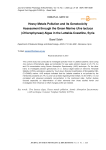
Статья научная
The current study was conducted to investigate pollution level in Lattakia-coastline, Syria using Ulva lactuca (Chlorophyta) algae as bioindicator for sea water pollution based on Zn, Pb, Cu and Cd concentration using Atomic Absorption Spectrometry (AAS) technique. On the other hand, to investigate pollution genotoxicity on U. lactuca algae based on Genomic Template Stability (GTS%) estimations yielded by Touch-down Directed Amplification of Minisatellite DNA (Td-DAMD) marker. AAS analysis indicated that the Lattakia coastline is not polluted by the mentioned pollutants (Zn, Pb, Cu and Cd) at least regarding these metals. As for GTS%, it is not correlated with observed pollutants concentration in the mentioned sites. Further studies focused especially on determination of other elements than those studied herein and investigation their influence on DNA changes profile are needed.
Бесплатно
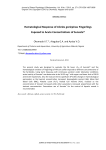
Hematological response of Clarias gariepinus fingerlings exposed to acute concentrations of Sunsate®
Статья научная
The present study was designed to evaluate the 96 hours LC 50 of sunsate® and the hematological variation of fingerlings of African catfish exposed to different concentrations of the herbicides. Using static bioassays with continuous aeration under laboratory conditions acute toxicity of Sunsate ® was determine to be 18.33 mg l -1 with upper and lower limit of 20.93 and 16.05 respectively. Also the toxicant led to significant (P® for the control of Aquatic weeds is recommended.
Бесплатно

